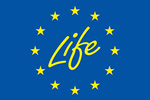ACTION A.1 – (October 2019 – March 2020)
Installation of wet and dry scrubber abating technologies in pig barns
A1.1 – Realization and installation of wet scrubber prototype
Two movable wet scrubbers will be built by Rota Guido to wash the air inside piggeries. One will be installed in Lombardia (Italy) and one in Catalonia (Spain). In each country two farms will be involved, and the scrubber will be switched after 9 months. In Italy will be installed in fattening farms and in Spain in farrowing farms. The switch will take place during the monitoring campaigns foreseen in Action B.1.
A1.2 – Installation of dry filter abatement system
In the same 4 farms, 4 dry scrubbers will be installed, one in each farm involved. The idea is to install each technology in different rooms of the same farms in order to compare the results in terms of abatement performance. The dry scrubber is a technology already adopted in others industrial context, such as the bakery industry. It will be modified to resist to the harsh environmental conditions of pig farms.
A1.3 – Installation of online monitoring tool of NUVAP
In the same 4 farms a microclimatic tool, provided by Nuvap srl, will be installed. It will be used to monitor the air quality inside piggeries, in particular NH₃, PM, GHG and VOCs concentrations. All data recorded by the Nuvap device will be available in a Cloud platform and in a mobile App. The Nuvap tools will be installed in the same rooms of the scrubbers and also alone in another room as a control. So, we will have 3 Nuvap tools in each farm of both countries.
ACTION A.2 – (October 2019 – March 2020)
Implementation, monitoring and evaluation protocols
The aim of this action is to define protocols for demonstration farms and reference scenario. This action will take place simultaneously with Action A.1. Three protocols will be defined: for PM emissions, for NH₃, GHG and VOCs emissions and for animal welfare.
-
For PM protocol, PM concentration will be monitored by a PM sampler which combines gravimetric technique with IR radiation.
-
For NH₃, 6 monitoring campaigns will be executed during the project, thus including different environmental conditions. NH₃ and GHG concentrations will be measured by Brüel & Kjaer instrument and by a chemical determination. Protocols will follow prescriptions of IRPP (Intensive Rearing of Poultry or Pigs) BREF. The odor concentration will be determined by olfactometric measurements and by GC-MS.
- Finally, protocol in animal welfare will be developed by IRTA, based on the Welfare Quality (WQ) protocol. The WQ protocol will be adapted to the present project by selecting indicators that fit with the environmental pollutants studied. Physiological measurements will be also defined, such as a blood sampling protocol to evaluate potential effects on the immune response capacity.
Protocols are crucial to obtain sound and profitable results from the experimental work and to avoid unexpected constraints.





